Weissenhorner Milch Manufaktur, Weissenhorn, Germany, produces a line of premium dairy products that feature a subtle packaging design that exudes refined pleasure. The basic cup shapes generally resemble those of widely available creamery products. An interesting feature is the use of carton sleeves for some product lines.
In August 2012, the company installed a high-speed TLM packaging line from Gerhard Schubert GmbH that runs five different cup sizes ranging from 125 to 475g with and without snap-on lids at speeds to 180 cups/min.
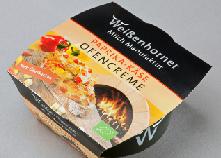
Many of Weissenhorner’s cups are packed in sleeves.
The flexibility and process reliability of TLM technology correspond to Weissenhorner's mindset of quality and innovation. To CEO Gerhard Jerg, the new line's design is the "whipped cream topping" of his investment.
Previously, the sleeves were handled by hand, as were the erecting and filling of the carton trays. The TLM packaging line from Schubert has completely automated these operations.
A unique feature of the Schubert TLM packing machine is that its various functions are carried out by individual robot cells. In the case of the Weissenhorner operation, all of the functions are housed in four sub-machines. The entire line is little more than eight meters long (about 26 feet).
TLM technology provides maximum flexibility in a small area. This flexibility is easily accessible, both physically for cleaning and virtually through the user-friendly HMI interface on the touchscreen.
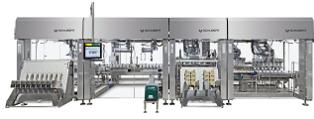
The TLM packaging line from Schubert has been in operation at Weissenhorner since August 2012. It is currently handling five different cup sizes (ranging from 125 to 478g) with and without snap-on lids.
Modular transport technology
The TLM machine features Schubert's innovative and recently patented Transmodule transport technology, which the company says is the world's first transport robot, to deliver sleeves to the assembly section of the machine.
The transmodule system consists of individual modules that travel through the machine on rails. Each transmodule has a vacuum pump, a servo drive motor and its own control electronics or electrical system.
The transmodule only requires power when accelerating from a standstill to its travel speed. When it decelerates to position itself for the robotic packing process, the drive motor switches over to generator mode, thereby supplying electricity stored in capacitors, which is used when starting up again. The Transmodule offers wireless data and power transfer and is linked to the machine's software control system.
At Weissenhorner, a TLM-F2 robot takes a sleeve blank out of a magazine and plaThe product conveyor transports the cups to the pick-up area of the TLM-F44 robots, which handle pre-grouping. The TLM-F44 robot consists of two four-axle pick-and-place robots equipped with grippers to grasp the cups. ces it into the folding frame of the transmodule, where it is erected in a U-shape. The blanks are secured by suction cups to prevent slippage.
The sleeves are carried through the entire machine by the transmodule. At the end, the module swivels downward and moves along the bottom of the rail back into the starting position while hanging from the rail. If a module should fail, the machine stops briefly, the next module pushes the defective module out of the system and the process continues.
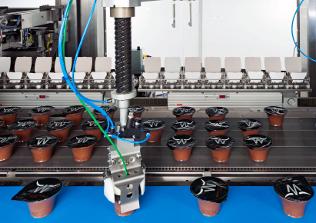
The product conveyor transports the cups to the pick-up area of the TLM-F44 robots, which handle pre-grouping. The TLM-F44 robot consists of two four-axle pick-and-place robots equipped with grippers to grasp the cups.
Twin-arm robot
The TLM-F2 robot is a twin-arm pivoting-type robot designed for packaging applications. The manipulator comprises gears and drives for movement of the upper and the lower arm. The lower arm carries the tooling at its end.
Both arms are individually driven by permanently energized servo drives with attached absolute encoders. The end of the robot is designed as a tool exchanger, and it has all of the devices necessary to control tools.
The programming of the TLM-F2 robot can be accomplished with any personal computer with appropriate configuration and Schubert programming software. The job sequence program is created by using either teach-in techniques or via a display terminal.
Robotic cup placement
Filled cups enter the machine and are conveyed on a product infeed conveyor to the pick-up area, where TLM-F44 robots position them properly on a grouping conveyor for pickup and loading into the sleeves. The TLM-F44 robot consists of two four-axle pick-and-place robots equipped with grippers to grasp the cups.
A TLM-F2 robot picks up the cups from the grouping The TLM uses TLM-F2 robots to handle cups and sleeves. During the filling procedure, a TLM-F2 robot picks up cups from the grouping belt and places them into the open sleeves. conveyor and places them into the sleeves, which have been labeled on the way to the cup-loading station. Another TLM-F2 robot closes the sleeves, which are glued while underway to the closing station.
A vision system provides data on the position and orientation of the cups on the product infeed conveyor and also identifies incorrect and faulty products, which are rejected at the end of the belt.
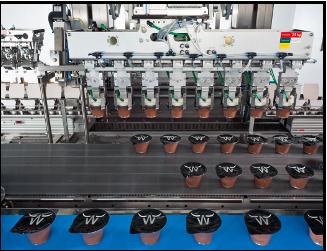
The TLM uses TLM-F2 robots to handle cups and sleeves. During the filling procedure, a TLM-F2 robot picks up cups from the grouping belt and places them into the open sleeves.
Tray loading
The transmodules transport the glued sleeves to the tray loading station. The TLM system incorporates Schubert's patented counter-running principle in which the cups and the trays into which the cups are packed enter the machine from opposite ends and run in opposite directions. This ensures that there are always enough products in the pick-up area of the picker. The speeds of both conveyors are matched to the machine production rate and are controlled automatically.
Just like the sleeves, the flat blanks for the carton trays are held in a magazine. A TLM-F2 robot retrieves a blank and places it on the conveyor, where it travels through a hot-melt gluing station followed by the folding unit.
Another TLM-F2 robot places the proper number of cups into the tray, after which it discharges from the system. The robot then pushes the filled trays onto the discharge belt.
If the cups are not to be placed in sleeves, the grouping belt brings them directly to the TLM-F2 robot, which transfers them to the trays.
Sustainability has been a guiding issue for Weissenhorner for more than two decades. CEO Jerg views Schubert as supporting him in his pursuit to apply the concept of sustainability in an economical way. "The packaging line provides us with reliable processes, which translates to fewer errors and rejects. It's also a solution which will be with us for a long time thanks to its quality and flexibility,' Jerg says.
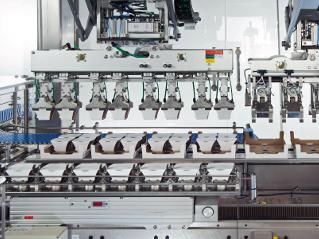
The product conveyor transports the cups to the pick-up area of the TLM-F44 robots, which handle pre-grouping. The TLM-F44 robot consists of two four-axle pick-and-place robots equipped with grippers to grasp the cups.
The products don’t leave the transmodule until the sleeves and cups are transferred to the waiting tray by another TLM-F2 robot.
The TLM packaging line from Schubert has been in operation at Weissenhorner since August 2012. It is currently handling five different cup sizes (ranging from 125 to 478g) with and without snap-on lids.
The TLM uses TLM-F2 robots to handle cups and sleeves. During the filling procedure, a TLM-F2 robot picks up cups from the grouping belt and places them into the open sleeves.
The products don't leave the transmodule until the sleeves and cups are transferred to the waiting tray by another TLM-F2 robot.





